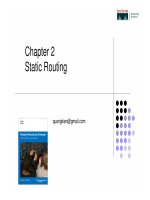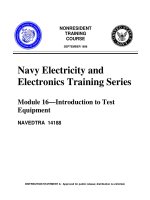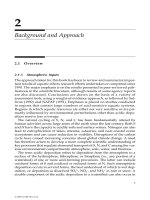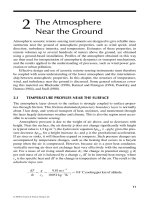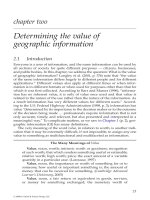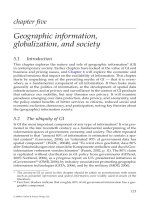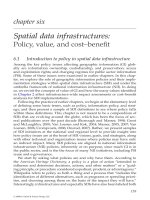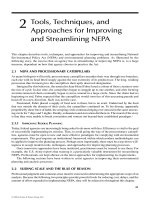PHYSICS 3 (ELECTRICITY AND MAGNETISM) - CHAPTER 2 pot
Bạn đang xem bản rút gọn của tài liệu. Xem và tải ngay bản đầy đủ của tài liệu tại đây (389.49 KB, 12 trang )
Electricity and Magnetism
18
Chapter 2
ELECTRIC ENERGY AND CAPACITANCE
2.1 Potential Difference and Electric Potential
1) Electric potential energy, electric potential difference and electric potential
Consider the system constituted by the charges Q and q in Fig. 2.1. The electric field E due to the charge
Q
E =
2
o
Q
4
πε r
[Vm
-1
], [NC
-1
] (2.1)
The electrostatic force F on the charge q
F = qE =
2
o
qQ
4
πε r
[N] (2.2)
When the charge q is released from point A, it moves away from Q, along the electric field line. The loss
in potential energy of the system as the charge q moves from A to B is the work done by the electric force
dW =
F.dr
uur
r
= Fdr =
2
o
qQdr
4
πε r
⇒
W =
B
A
r
2
o
r
qQdr
4
πε r
∫
=
o A B
qQ 1 1
-
4
πε r r
[J] (2.3)
The work done by the electrostatic force is path independent. It depends only on the initial point A and the
final point B and is the same for all paths between A and B.
Fig. 2.1
The change in the potential energy of the system
∆U = U
B
- U
A
= -W (2.4)
where U
A
and U
B
are the potential energy of the system when the charge q is at A and B, respectively.
When q moves from A to B, ∆U < 0 : the electric force F does work W > 0 and the system loses energy.
If we set the potential energy of the system U
B
= 0 at infinity, i.e. r
B
= ∞ (the reference point of zero
potential at infinity) then it follows from (2.3) and (2.4) that
Electricity and Magnetism
19
U
A
=
o A
4
πε r
[J] (2.5)
The electric potential (the potential energy per unit charge) at point A is defined as
V
A
=
A
U
q
=
o A
Q
4
πε r
[J/C], [V] (2.6)
The electric potential difference between A and B is the difference in potential energy per unit charge
∆V =
U
q
∆
= -
q
W
= -
o A B
Q 1 1
-
4
πε r r
= V
B
- V
A
[J/C], [V] (2.7)
2) Equipotential surfaces
The points on an equipotential line all have the same electric potential. Equipotential lines are always
perpendicular to the electric field. In three dimensions, the lines form equipotential surfaces. Movement
along an equipotential line (or an equipotential surface) requires no work because such movement is
always perpendicular to the electric field.
For a point charge, the equipotential lines are circles centered on the charge (Fig. 2.2.a). The dashed lines
illustrate the scaling of voltage at equal increments. The equipotential lines get further apart with
increasing r.
(a) (b) (c)
Fig. 2.2 : Dashed lines : equipotential lines. Solid lines : electric field lines.
The electrical potential of a dipole shows mirror symmetry about the center of the dipole (Fig. 2.2.b).
They are everywhere perpendicular to the electric field lines.
For parallel conducting plates like those in a capacitor, the electric field lines are perpendicular to the
plates and the equipotential lines are parallel to the plates (Fig. 2.2.c).
Electricity and Magnetism
20
2.2 Potential Difference in a Uniform Electric Field
The potential difference between two points A and B in a uniform electric field (Fig. 2.3)
V = Ed [V] (2.8)
Fig. 2.3
2.3 Electric Potential and Potential Energy Due to Point Charges
1) The electric potential due to a single point charge at a distance r from that point charge
V =
r4
q
o
πε
(2.9)
The electric potential due to a collection of point charges
V =
∑
=
πε
n
1
i
i
i
o
r
q
4
1
(2.10)
2) The electric potential of a dipole at a distance r from the dipole can be found by superposing the electric
potential of two point charges (Fig. 2.4)
V =
+
πε r4
q
o
-
−
πε r4
q
o
=
−+
+−
πε
−
rr4
)rr(q
o
(2.11)
Fig. 2.4 Fig. 2.5
Electricity and Magnetism
21
If r >> d then r
-
- r
+
≈
dcos(
θ
) and r
-
r
+
≈
r
2
. (2.11) can be approximated by
V =
2
o
r4
)cos(p
πε
θ
(2.12)
where p = qd is the dipole moment.
The electric dipole moment for a pair of opposite charges of magnitude q is defined as the magnitude of
the charge times the distance between them and the defined direction is toward the positive charge. It is a
useful concept in atoms and molecules where the effects of charge separation are measurable, but the
distances between the charges are too small to be easily measurable. It is also a useful concept in
dielectrics and other applications in solid and liquid materials.
2.4 Electric potential due to continuous charge distributions
The electric potential due to a continuous charge distribution
V =
∫
πε r
dq
4
1
o
(2.13)
2.5 Electric potential due to a charged conductor
Since the electric field E = 0 for all points inside an isolated conductor, an excess charge placed on an
isolated conductor lies entirely on its surface. All points on the conductor have the same potential (even if
the conductor has an internal cavity and even if that cavity contains a net charge.
2.6 Capacitance
A capacitor consists of two isolated conductors (the plates) with charges +q and –q. Initially when the
battery is not connected, the two plates are neutral. When the battery is connected, electrons will flow
until the potential difference between plate A and positive terminal of the battery is zero, and the potential
difference between plate B and the negative terminal of the battery is zero. The capacitance C [F] is
defined as
q = CV (2.14)
where V is the potential difference between the plates. The direction of V relates to q as given in Fig.2.7.
Fig. 2.6 Fig. 2.7
1) A parallel-plate capacitor
(Fig. 2.8)
Gauss’ law
⇒
q =
ε
o
AE
⇒
E =
A
q
o
ε
(A : the area of the plate)
Electricity and Magnetism
22
By definition
V =
∫
sdE
r
r
= Ed =
A
qd
o
ε
(the integral is taken in the direction of the electric field E, see also Fig. 2.7)
⇒
C =
V
q
=
d
A
o
ε
[F] (2.15)
Fig. 2.8 : A parallel-plate capacitor Fig. 2.9 : A cylindrical capacitor
2) A cylindrical capacitor
(Fig. 2.9)
Gauss’ law
⇒
q =
ε
o
(2
π
rL)E
⇒
E =
rL2
q
o
πε
(2
π
rL : the area of the curved part of the Gaussian surface, L the length of the cylinder)
Let a and b to be the radius of the inner cylinder and the outer cylinder, respectively. By definition
V =
∫
b
a
sdE
r
r
=
∫
πε
b
a
o
rL2
qdr
=
)
a
b
ln(
L2
q
o
πε
(a < b : radii)
(the integral is taken in the direction of the electric field E, see also Fig. 2.7)
⇒
C =
V
q
=
)
a
b
ln(
L2
o
πε
(2.16)
3) A spherical capacitor
The capacitor consists of a solid conducting sphere of radius a surrounded by a spherical shell of inner
radius b. These are the plates of the capacitor. The solid sphere has a +Q on its top surface, which induces
a charge of -Q on the inner surface of the outer shell. This in turn induces +Q charge on the outer surface
of the outer shell.
Gauss’ law
⇒
q =
ε
o
(4
π
r
2
)E
⇒
E =
2
o
r4
q
πε
(4
π
r
2
: the area of the sphere)
By definition
V =
∫
b
a
sdE
r
r
=
∫
πε
b
a
2
o
r4
qdr
=
)
b
1
a
1
(
4
q
o
−
πε
(a < b : radii)
(the integral is taken in the direction of the electric field E, see also Fig. 2.7)
⇒
C =
V
q
=
a
b
ab4
o
−
πε
(2.17)
4) An isolated sphere
b
→
∞
: (2.17)
⇒
C = 4
πε
o
a (2.18)
Electricity and Magnetism
23
2.7 Combinations of Capacitors
1) Capacitors in Parallel
C
eq
=
Σ
C
i
(2.19)
2) Capacitors in Series
∑
=
ieq
C
1
C
1
(2.20)
2.8 Energy Stored in a Charged Capacitor
The work W required to bring the total capacitor charge up to q
q = CV
dW = Vdq =
C
q
dq
⇒
W =
C
2
q
2
=
2
CV
2
this work W is stored as potential energy U in the capacitor
C
2
q
2
CV
U
22
==
[J] (2.21)
The energy density u is the potential energy per unit volume. In case of a parallel-plate capacitor
2
E
u
2
o
ε
=
(2.22)
2.9 Capacitors with Dielectrics
1) Dielectric
Non polar dielectric: the center of positive charges coincide with the one of negative charges
⇒
the
molecules are neutral.
Polar dielectric : the center of positive charges doesn’t coincide with the one of negative charges
⇒
each
molecule is a dipole.
A) polar dielectric B) non polar dielectric
Fig. 2.10 : In absence of an external electric field.
Electricity and Magnetism
24
Under the effect of an external electric field, the molecules of non polar dielectric become dipoles. The
electric dipoles tend to line up with the external electric field.
A) vacuum B) dielectric
Fig. 2.11 : With the same charge, the electric field in case A is stronger than case B
2) The electric field produced by charge inside a dielectric
The electric field of a point charge inside a dielectric
2
o o
q
E =
4
πk ε r
(2.23)
Gauss’ law with a dielectric
k
o
ε
o
Φ
= q (2.24)
k
o
: dielectric constant
Material Dielectric constant k
o
Dielectric strength (kV/mm)
Air (1 atm)
Polystyrene
Paper
Transformer oil
Pyrex
Porcelain
1.00054
2.6
3.5
4.5
4.7
6.5
3
24
16
14
Problems
Electric potential
2.1) Find the electric potential inside and outside a sphere of radius R and of constant volume charge density
ρ
.
2.2) Find the electric potential inside and outside a spherical conducting shell of radius R with total charge +Q.
2.3) A total charge of +Q is uniformly distributed along the length of a rod of length L (Fig. P2.1). Determine
the electric potential at point P, a distance a from one end of the rod as shown.
Fig. P2.1
Electricity and Magnetism
25
2.4) Determine an expression for the potential difference between two points A and B in Fig. P2.2. Suppose
that the electric field is constant.
2.5) Determine an expression for the potential difference between two points A and C in Fig. P2.2. Suppose
that the electric field is constant.
Fig. P2.2 Fig. P2.3
2.6) The thin plastic rod shown in Fig. P2.3 has length L = 12cm and a nonuniform linear charge density
λ
=
α
x where
α
= 28.9pC/m
2
. With V = 0 at infinity, find the electric potential at P
1
and P
2
. Where d
1
= 8cm,
d
2
= 3cm.
2.7) Three particles, charge q
1
= 10
µ
C, q
2
= -20
µ
C, q
3
= 30
µ
C, are positioned at the vertices of an isosceles
triangle as shown in Fig. P2.2. If a = 10cm and b = 6cm, how much work must an external agent do to
exchange the position of
a) q
1
and q
3
.
b) q
1
and q
2
.
Fig. P2.4
2.8) A non conducting sphere has radius R = 2cm and uniformly distributed charge q = 3.5fC. Take the electric
potential at the sphere center to be V
o
= 0. What is V at radial distance
a) r = 1.5 cm
b) r = R.
Capacitance
2.9) A metal plate of thickness a is inserted in-between the plates which are separated by a distance d (Fig.
P2.5). Find the capacitance of the system.
Electricity and Magnetism
26
Fig. P2.5 Fig. P2.6
2.10) What happens if the outer surface of the capacitor is connected to Earth ? (Fig. P2.6)
Answer: The electrons from Earth neutralize the outer surface only. The inner surface still maintains a
total charge of -Q, which means that the electric field within the capacitor is unaffected. Thus, the
potential difference remains the same, and therefore, there is no loss of energy from the capacitor.
2.11) Consider a parallel plate capacitor with rectangular plates and a sheet of metal of thickness a. The
dimensions of the capacitors are given in the Fig. P2.7. Let x be the length of the metal plate that is
inserted between the capacitor plates. Let +Q and -Q be the charges on the plates of the capacitor.
a) Find the capacitance C
o
and the energy U
o
stored in the capacitor before the metal sheet is inserted.
b) Find the capacitance C and the energy U stored in the capacitor after insertion of the metal sheet as
function of x.
c) Find the force on the metal sheet ? Which direction does it tend to move the metal sheet ?
Fig. P2.7 Fig. P2.8
2.12) Two long conducting wires of length L and radius a lie parallel a distance s apart (Fig. P2.8). The upper
wire carries charge Q and the lower charge -Q. Since L >> s, we may assume the wires are effectively
infinitely long for purpose of finding the electric fields and potentials.
a) Find the electric field E in the plane in between the wires.
b) Find the potential
ϕ
in the plane between the wires. Find V, the potential different between the wires.
c) Find the capacitance C of the two wire system.
d) Find the total electrical energy stored in the system.
2.13) Find the capacitance C of a cylindrical capacitor of length L and radii a and b (Fig. P2.9).
Electricity and Magnetism
27
top view side view
Fig. P2.9
2.14) The parallel plate capacitor in Fig. P2.10 has plate area A = 100 cm
2
and plate separation d = 1 cm. A
potential difference V
o
= 50 V is applied between the plates. The battery is then disconnected. A dielectric
slab of thickness b = 0.8 cm and dielectric constant k = 2 is placed between the plates after the battery was
removed
a) Before the dielectric slab is inserted, find the capacitance and the charge on the plate.
b) After the slab has been introduced, find
- the electric field in the gaps between the plates and the dielectric slab.
- the electric field in the dielectric slab.
- the capacitance between the plates.
- the potential difference between the plates.
Fig. P2.10
Electricity and Magnetism
28
Homeworks 2
H2.1 A total charge of +Q [fC] is uniformly distributed along the length of a rod of length L [mm] (Fig. H2.1).
Determine the electric potential at point P, a distance a [mm] from one end of the rod as shown.
Fig. H2.1 Fig. H2.2
n 1 2 3 4 5 6 7 8 9 10 11 12 13 14 15 16
Q 1 2 3 4 5 6 7 8 9 10 11 12 13 14 15 16
L 21 22 23 24 25 26 27 28 29 21 22 23 24 25 26 27
a 24 25 26 27 28 29 24 25 26 27 28 29 25 26 27 28
n 17 18 19 20 21 22 23 24 25 26 27 28 29 30 31 32
Q 1 2 3 4 5 6 7 8 9 10 11 12 13 14 15 16
L 22 23 24 25 26 27 28 29 22 23 24 25 26 27 28 29
a 21 22 23 24 25 26 27 28 29 21 22 23 24 25 26 27
n 33 34 35 36 37 38 39 40 41 42 43 44 45 46 47 48
Q 1 2 3 4 5 6 7 8 9 10 11 12 13 14 15 16
L 23 24 25 26 27 28 29 22 23 24 25 26 27 28 29 21
a 22 23 24 25 26 27 28 29 22 23 24 25 26 27 28 29
n 49 50 51 52 53 54 55 56 57 58 59 60 61 62 63 64
Q 1 2 3 4 5 6 7 8 9 10 11 12 13 14 15 16
L 24 25 26 27 28 29 24 25 26 27 28 29 25 26 27 28
a 25 26 27 28 29 22 23 24 25 26 27 28 29 25 26 27
H2.2 Consider a parallel plate capacitor with rectangular plates and a sheet of metal of thickness a. The
dimensions of the capacitors are given in [mm] (Fig. H2.2). Let x be the length of the metal plate that is
inserted between the capacitor plates. Let +Q and -Q be the charges [fC] on the plates of the capacitor.
a) Find the capacitance C
o
and the energy U
o
stored in the capacitor before the metal sheet is inserted.
b) Find the capacitance C and the energy U stored in the capacitor after insertion of the metal sheet as
function of x.
c) Find the force on the metal sheet ? Which direction does it tend to move the metal sheet ?
n 1 2 3 4 5 6 7 8 9 10 11 12 13 14 15 16
Q 1 2 3 4 5 6 7 8 9 10 11 12 13 14 15 16
a 1.1 1.2 1.3 1.4 1.5 1.1 1.2 1.3 1.4 1.5 1.1 1.2 1.3 1.4 1.5 1.1
d 1.2 1.3 1.4 1.5 1.6 1.7 1.2 1.3 1.4 1.5 1.6 1.7 1.2 1.3 1.4 1.5
w 20 21 22 23 24 25 26 27 28 29 30 31 32 33 34 35
L 31 32 33 34 35 36 37 38 39 40 41 42 43 44 45 46
Electricity and Magnetism
29
n 17 18 19 20 21 22 23 24 25 26 27 28 29 30 31 32
Q 1 2 3 4 5 6 7 8 9 10 11 12 13 14 15 16
a 1.5 1.6 1.7 1.8 1.9 1.5 1.6 1.7 1.8 1.9 1.5 1.6 1.7 1.8 1.9 1.5
d 1.2 1.3 1.4 1.5 1.6 1.7 1.2 1.3 1.4 1.5 1.6 1.7 1.2 1.3 1.4 1.5
w 31 32 33 34 35 36 37 38 39 40 41 42 43 44 45 46
L 20 21 22 23 24 25 26 27 28 29 30 31 32 33 34 35
n 33 34 35 36 37 38 39 40 41 42 43 44 45 46 47 48
Q 1 2 3 4 5 6 7 8 9 10 11 12 13 14 15 16
a 1.3 1.4 1.5 1.6 1.7 1.8 1.3 1.4 1.5 1.6 1.7 1.8 1.3 1.4 1.5 1.6
d 1.2 1.3 1.4 1.5 1.6 1.7 1.2 1.3 1.4 1.5 1.6 1.7 1.2 1.3 1.4 1.5
w 22 23 24 25 26 27 28 29 30 31 22 23 24 25 26 27
L 31 32 33 34 35 36 37 38 39 40 41 42 43 44 45 46
n 49 50 51 52 53 54 55 56 57 58 59 60 61 62 63 64
Q 1 2 3 4 5 6 7 8 9 10 11 12 13 14 15 16
a 1.7 1.8 1.3 1.4 1.5 1.6 1.7 1.8 1.3 1.4 1.5 1.6 1.7 1.8 1.3 1.4
d 1.2 1.3 1.4 1.5 1.6 1.7 1.2 1.3 1.4 1.5 1.6 1.7 1.2 1.3 1.4 1.5
w 26 27 28 29 30 31 22 23 24 25 26 27 26 27 28 29
L 20 21 22 23 24 25 26 27 28 29 20 21 22 23 24 25
